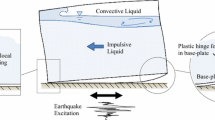Abstract
Under strong earthquake motions, the liquid stored within large unanchored steel tanks can cause rocking and uplift of the tank base from the supporting foundation. Repeated rocking can lead to low-cycle fatigue fractures in the tank base-plate, and ultimately spillage of tank contents. Due to limited research on tank connection capacity, current European and New Zealand tank standards (EuroCode8 part 4 and NZSEE) impose unjustified rotation limits on tank shell-to-base connections (current limit being 0.2 rad). These rotation limits often govern the design of new tanks, and many existing tanks require retrofit to meet compliance. This paper experimentally investigates the fatigue capacity of tank shell-to-base connections, with a focus on the effects from material ductility and applied strain range (rotation range). Twenty-seven tank connections representing two steel material grades are fatigue tested under constant range rotation cycles to generate fatigue-life curves. Tensile loads applied to the base-plate simulate membrane action present in tanks during uplift. Results indicate that the strain capacity of the base-plate base material strongly influences connection fatigue capacity as fatigue fractures originate in the base material away from the weld toe and weld heat affected zone. Increasing base-plate ductility drastically increases connection fatigue life. All connection specimens sustained multiple uplift cycles at rotations greater than the existing EuroCode8 and NZSEE limits.
Similar content being viewed by others
References
ASTM E-8 (2002) Standard test methods for tension testing of metallic materials. E8, West Conshohicken
ASTM E-384 (2011) Standard test method for Knoop and Vickers hardness of materials. E384, in annual book of ASTM, vol 03.01, West Conshohicken
Coffin LF Jr (1954) A study of the effects of cyclic thermal stresses in ductile metals. ASME 76: 931–950
Cortes G, Nussbaumer A, Berger C, Lattion E (2011) Experimental determination of the rotational capacity of wall-to-base connections in storage tanks. J Constr Steel Res 67: 1174–1184
Eurocode-3 (1992) Part 1-1: general rules and rules for buildings. ENV 1993-1-1, European Committee for Standardization, Brussels
Eurocode-8 (1998) Part 4: silos, tanks, and pipelines. ENV 1998-4, European Committee for Standardization, Brussels
Fujikazu S, Akira I, Hajime H, Yukio M (1988) Experimental study on uplifting behavior of flat-based liquid storage tanks without anchors. In: Proceedings of the 9th world conference on earthquake engineering. Tokyo-Kyoto, pp 649–654
Haroun MA (1983) Behaviour of unanchored oil storage tanks: imperial valley earthquake. J Tech Topics Civ Eng 109(1): 23–38
Housner GW (1963) The dynamic behavior of water tanks. Bull Seismol Soc Am 53(2): 381–387
Huther M, Galtier A, Marquis G (2008) Guidance for the application of the best practice guide on statistical analysis of fatigue data. International Institute of Welding (IIW). Commission XIII-WG1-132-108
Jacobsen LS (1949) Impulsive hydrodynamics of fluid inside a cylindrical tank and of fluid surrounding a cylindrical pier. Bull Seismol Soc Am 39(3): 189–203
Koller M (2003) Erdbebensicherheit bestehender unverankerter stehtanks in bezug auf storfallrelevante schaden. Report No. TB 245-02/MK. Resonance Ingenieurs-Conseils
Leon GS, Kausel EAM (1986) Seismic analysis of fluid storage tanks. J Struct Eng 112(1):1–18
Malhotra PK (1995) Base uplifting analysis of flexibly supported liquid-storage tanks. Earthq Eng Struct Dyn 24: 1591–1607
Malhotra PK, Veletsos AS (1994a) Beam model for base-uplifting analysis of cylindrical tanks. J Struct Eng 120(12): 3471–3488
Malhotra PK, Veletsos AS (1994b) Uplifting analysis of base plates in cylindrical tanks. J Struct Eng 120(12): 3489–3505
Manos GC, Clough RW (1985) Tank damage during the May 1983 Coalinga earthquake. Earthq Eng Struct Dyn 13: 449–466
Manson SS (1954) Behavior of materials under conditions of thermal stress. National Advisory Committee for Aeronautics. Technical note 2933. Tennessee (USA)
NZSEE (2009) Seismic design of storage tanks. New Zealand National Society for Earthquake Engineering, Wellington
Peek R (1988) Analysis of unanchored liquid storage tanks under lateral loads. Earthq Eng Struct Dyn 16: 1087–1100
Peek R, Jennings PC (1988) Simplified analysis of unanchored tanks. Earthq Eng Struct Dyn 16: 1073–1085
Prinz GS, Nussbaumer A (2012) Fatigue analysis of liquid storage tank shell-to-base connections under multi-axial loading. Eng Struct 40: 75–82
SIA (1892) Fur die Berechnung, die Ausfuhrung und den Unterhait der Bauten aus Stahl, Beton, Eisenbeton und Holz—Teil 2. Normen des Schweizerischer Ingenieur und Architektenverein, Switzerland
Author information
Authors and Affiliations
Corresponding author
Rights and permissions
About this article
Cite this article
Prinz, G.S., Nussbaumer, A. On the low-cycle fatigue capacity of unanchored steel liquid storage tank shell-to-base connections. Bull Earthquake Eng 10, 1943–1958 (2012). https://doi.org/10.1007/s10518-012-9382-7
Received:
Accepted:
Published:
Issue Date:
DOI: https://doi.org/10.1007/s10518-012-9382-7




